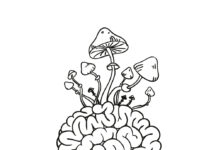Physical Pain and Mental Pain
When it comes how to respond to your physical pain and your emotional pain, you always have a choice.
With physical pain, we would be in big trouble if we could not locate it in our body via the direct inner experience of feeling it. How would we know how to deal with the pain (how to move, how to sit, or how to lie down without further injury) if we couldn’t sense its location directly in our body? Sometimes pain relievers make the important work of the body—to find and heal the injury—more bearable, but we need to allow body sense to play a role in feeling what our body needs.
As with physical pain, an analgesic might help temporarily, but it won’t heal the underlying issue. It won’t take away the unresolved feelings that never got seen or expressed or even really felt. In order to get over grief, resolve anger, and even embrace happiness, we have to really feel those things in the body.
We are indeed quick to access the body locations of pleasurable feelings (food, drink, sex, warmth, touch) so why not let ourselves go to the places of emotional pain? Yes, it does hurt for a while, but then—miraculously—there can be relief and the emergence of a new perspective on us and others.
“Between stimulus and response there is a space. In that space is our power to choose our response. In our response lies our growth and our freedom.” —Viktor Frankl
Pain and Suffering
It surprising how often the two words “pain” and “suffering” are used interchangeably.
However, the two concepts are far from identical—we can find examples when one occurs without the other. There can be pain without suffering; the example that first comes to mind is that of sexual masochists who derive erotic pleasure from some forms of pain. But one doesn’t need to be a masochist to experience pain without suffering.
A lot of people enjoy spicy food, which induces burning pain in the mouth because capsaicin (the chemical responsible for the pungency of these foods) activates the TRPV1 channel, the initiator of heat-induced pain.
Another example is that of athletes and other sports enthusiasts, who learn that pain is part of their favourite sport. Runners, bicyclists, skiers, they all know that pain from muscular fatigue is a sign that the exercise is being effective, that their muscles will grow as a result of it. “Feel the burn”, they say. Rock climbers know that jamming the fist in that crack will be painful, but that’s what is required by that technique. Pain is part of the sport and we learn to welcome it.
Then, of course, there can be suffering without pain!
In fact, most of our suffering has nothing to do with pain. It is induced by negative emotions like sadness, shame, or guilt, or by situations like deprivation of freedom, loneliness, distress, depression, empathy, social rejection, oppression, etc. Like its opposite, happiness, suffering is neither a sensation nor an emotion, but a state of being that encompasses the whole mind.
The importance of understanding suffering cannot be overstated. Avoiding or lessening suffering is one of the major goals of our lives, and therefore it has a huge social and political significance. We do investigate sources of suffering like disease and hunger, but it is also clear that a lot of suffering is internally generated. This should be better understood.
Suffering and Consciousness
First, if pain requires consciousness, suffering needs it doubly so. There cannot be suffering if there is nobody experiencing it, no awareness of it.
Suffering cannot be separated from cognition and cultural heritage. Perhaps the deepest form of suffering is existential angst, a dissatisfaction that comes from consciousness itself. We know that we exist and we wonder what that means. Being happy or miserable depends on finding meaning to our lives. This quest for meaning is basically a cognitive endeavour encompassing our emotions, our ideas, and the cultural environment that gave them to us.
Stimulus and Response
Physical pain has distinct biological and psychological components that effectively represent stimulus and response. The biology of pain is the signal transmitted through the central nervous system that “something is wrong.” The psychology of pain is the interpretation or meaning we give to that pain signal—the internal self-talk and the beliefs about it which then drive our emotional reactions.
Suffering results from mental and emotional responses to pain. The biological and psychological facets of chronic pain combine to become like a smoke detector that goes on and stays on, continuously sounding a harrowing alarm at high volume.
Recovery from chronic pain distinguishes between the actual pain and the suffering it causes, and focuses on achieving relief from that suffering. Pain is unavoidable; suffering is not. It occurs in response to thoughts such as: “Why me?!” “It isn’t fair!” “This is horrible!” and “I can’t stand it!”
Suffering is both a cause and an effect of the disastrous cognitions and distressing emotions associated with chronic pain: anxiety, irritability, anger, fear, depression, frustration, guilt, shame, loneliness, hopelessness, and helplessness. Negative thinking only makes situations we believe to be bad even worse.
Negative Thinking and Suffering
Most people, including those who are not suffering from chronic pain, can ruminate on something by continuously and unproductively replaying it in their minds or magnifying the negative aspects of it. Our thoughts have tremendous capacity to make us miserable, and negative thinking can be especially insidious, feeding on itself, with the potential to become a self-fulfilling, yet self-defeating prophecy.
For people with chronic pain, it’s indeed a vicious circle: Pain triggers negative thoughts and self-talk, which translate to feelings of suffering, and that increases muscle tension and stress. This, in turn, amplifies pain signals, triggering more of them!
The progression is essentially as follows:
Pain leads to negative thoughts/self-talk/beliefs, which lead to feelings of frustration/anger/anxiety/fear/sadness/depression/hopelessness, which lead to suffering, which leads to muscle tension and stress, which leads to more pain, and so on. The longer such a cycle continues, the more out of balance a person tends to become.
Suffering can be altered when people become consciously aware of this chain reaction and learn how to respond differently to their pain. The process of pain recovery includes dramatically changing the negative progression starting with regaining cognitive and emotional balance through the application of acceptance strategies and mindfulness-based practices.
This is the principle behind mindfulness-based stress reduction, which was designed to incorporate Buddhist practices into chronic pain treatment.
How to Counteract Suffering
The conscious awareness of negative thinking/self-talk and how it sets off the cascade of events that fuels suffering can lead to mindful acceptance and detached observation of thoughts. This can lead to reduced suffering, decreased feelings of frustration/anger/anxiety/fear/sadness/depression/hopelessness, and lower stress and muscle tension—less pain.
Is this easy? Of course not! However, it is completely possible. By adjusting our thinking, and how we think about our thinking, we can change our emotional responses, the extent to which we suffer (or not), our level of tension and stress, and in turn, our experience of pain.
Suffering is not a mere sensation, like pain. Neither is it an emotion, like sadness or fear. It’s a state that encompasses our whole mind, which is made not just of negative emotions but also of thoughts, beliefs and the quality of our consciousness itself. Suffering, like its opposite, happiness, is a state of being.
For now, we should consider in awe how our unique consciousness is both a blessing and a curse because it enables us to suffer—and experience joy—more deeply than would have been possible without it.















I fully subscribe to the quote:
“Between stimulus and response there is a space. In that space is our power to choose our response. In our response lies our growth and our freedom.” —Viktor Frankl
In the context of hearing voices I apply this idea very successfully to interrupt the reaction/response process and deliberately (=mindfully) take control of my response. Most frequently I turn my attention to something interesting or fun in my immediate environment. I displace the voice stimuli and replace them with something I can appreciate.
In Neuro Linguistic Programming this is called an interrupt/replace technique and it works very well quickly becoming a habit. It is akin to SloMo Therapy being studied at Kings College in a more proactive form.
The voices I hear are very aggressive and have purported to be everything from the neighbours to a clandestine gang to spirits to God and minions. In a string that THEY made sense of in various plot twists, rationalising themselves. To counter this ‘re-invention’ as something else I took to naming my voices using childish names, going so far as to exaggerate their worst features in caricatures that I had drawn up by an artist… to shut down multiple variations of what they claimed to be and to mock the levers they use in their stance towards me (they are what I name them is my approach). This is akin to Avatar Therapy in self help mode, also being studied at Kings College.
In this way I reduce the strength of my reaction to voices, using their silly name to interrupt them and own my response. This reduces ‘suffering’.
Similarly, there were ideas that voices badgered with me where managing the reaction/response was more difficult. For example , when ‘God’ is making threats of eternal hell in some pretty extreme states that give the idea credence at the time… it is difficult to get the brain out of the fear response using everyday stimuli.
It isn’t easy to convince the brain that this is NOT possible, when we live in a world where ‘God’ has intervened in the course of human history in the form of four major revealed religions.
Here I adopted a form of exposure therapy. I learned to spot the themes of these kinds of threats (recognise them and the nature of them) and then introduced them into my interrupt/replace routine in my own time on my own terms. In time I reduced the extreme in my emotional reaction to the threats voices made. Vestre Viken Hospital Trust in Norway is using something similar in drug free approaches. (Look up “Drug-free after basal exposure therapy, Vestre Viken”)
These are all concrete steps applied mindfully – by which I mean making a deliberate choice about which stimuli I am paying attention to and giving meaning to – switching the predictive flow which calls up the ‘implications’ we experience from the automatic response to a focus of my choice. This is a more active intervention than some descriptions of mindfulness and it works by working WITH the natural processes of perception and cognition.
I don’t think we have to ‘suffer’ to change our perspectives. We need to ‘recognise’ the problem we want to address, which will have an emotional quotient that is gentler than ‘suffering’ it. From that’space’ that Frankl refers to (objectivity in my language) we can model different perspectives and edit our representation of the world or response frame of reference, without experiencing it as suffering.
Report comment